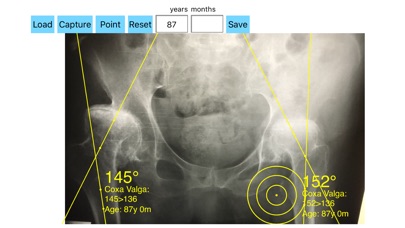
NeckShaftAngle App
Description
The Femoral Neck-Shaft-Angle (NSA) also known as caputcollum-diaphyseal (CCD) angle is one of the most frequently applied anatomic measure for the evaluation and description of the geometry of the hip in everyday orthopeadic care. Its key role during the decision-making process for conservative and operative management particular, in Developmental Dysplasia of the hip, the planning of correction-osteotomies, total hip replacements and the osteosynthesis of proximal femoral fractures etc. Measuring angles in X-rays with instruments like protractors or goniometers in clinical settings its time consuming and difficult because It is required to be carried by orthopaedic surgeon always things like a well sharped pencil, rulers or protractor or even transparent papers. Routinely in a busy everyday practice you miss or you forget one or another. This way is old fashioned and cumbersome .
NSA app is a medical software aimed for orthopaedic surgeons, providing tools that allow doctors to
-Securely import medical images directly from the camera or stored photos
-Offers a very convenient way to determine the most accurate possibly lines in order to measure the angle. By the aid of a circular template, four points of interest are marked. The automatically formed lines drawn between points give an angle which is measured automatically by the App. The visualized results are in degrees.
By inputing the age of the patient in the App, the measured angle is compared with values from normal reference database (see reference) according the patient age. In case the measured angle is increased or decreased, the hip is valgus or varus respectively.
-Save the planned images, for later review or consultation
All information received from the software as output must be clinically reviewed regarding its plausibility before patient treatment! NSA App is indicated for assisting healthcare professionals. Clinical judgment and experience are required to properly use the software. The software is not for primary image interpretation.
The app is not a simple goniometer which simply measures the angle, is an enhanced product which offers the ability to compare all the input data with medical reference database. This feature it is particular useful especially in clinical settings where you need a quick result without losing time in looking for reference data according to age variation in huge textbooks. The circular template to determine the points of interest and to mark them accurately are very useful in clinical settings where to find a sharpened pencil, a protractor and to draw with ruler lines over the patients x-rays is cumbersome and tedious task. You can take a photo of x-rays images of the patient in you mobile phone or tablet, the App simply guides you to do the rest. Its really a handy tool to medical doctor
Reference databases
1. Hartel, M.J., et al., Determination of femoral neck angle and torsion angle utilizing a novel three-dimensional modeling and analytical technology based on CT datasets. PLoS ONE, 2016.
2. Boese, C.K., et al., The neck shaft angle: CT reference values of 800 adult hips. Skeletal Radiology, 2016. 45: p. 455-463.
3. Boese, C.K., et al., The femoral neck-shaft angle on plain radiographs: a systematic review. Skeletal Radiology, 2016. 45: p. 19-28.
4. Jiang, N., et al., Femoral version, neck-shaft angle, and acetabular anteversion in Chinese Han population: a retrospective analysis of 466 healthy adults. Medicine (Baltimore), 2015. 94(21): p. e891.
5. Han, M., Y. Zhang, and T. Shan, Femoral Offset and its Relationship to Femoral Neck-shaft Angle and Torsion Angle Desplazamiento Femoral y su Relación con el Ángulo Cuello-Diáfisis Femoral y . Int. J. Morphol, 2014. 32: p. 1194-1198.
6. Von Lanz T, Wachsmuth W: Praktische Anatomie, Berlin, 1938, Julius Springer, p.143.


